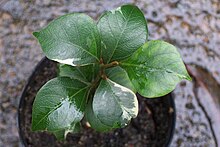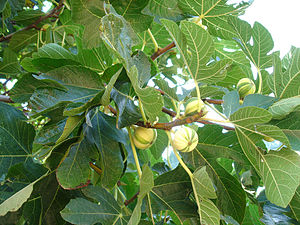Variegation
This article has multiple issues.Please helpimprove itor discuss these issues on thetalk page.(Learn how and when to remove these messages)
|

Variegationis the appearance of differently coloured zones in the leaves and sometimes thestemsand fruit of plants. Species with variegated individuals are sometimes found in theunderstoryoftropical rainforests,and this habitat is the source of a number of variegated houseplants.[1]Variegation is caused by mutations that affect chlorophyll production or by viruses, such asmosaic viruses,which have been studied by scientists. The striking look of variegated plants is desired by many gardeners, and some have deliberately tried to induce it for aesthetic purposes. There are a number of gardening books about variegated plants, and some gardening societies specialize in them.
The term is also sometimes used to refer to colour zonation in flowers, minerals, and the skin, fur, feathers or scales of animals.
Causes
[edit]Chimeral
[edit]
Plants that arechimerascontain tissues with more than onegenotype.A variegated chimera contains some tissues that produce chlorophyll and other tissues which do not.[2]Because the variegation is due to the presence of two kinds of plant tissue, propagating the plant must be by a vegetative method of propagation that preserves both types of tissue in relation to each other. Typically, stemcuttings,bud and stemgrafting,and other propagation methods that results in growth from leaf axil buds will preserve variegation. Cuttings with complete variegation may be difficult, if not impossible, to propagate. Root cuttings will not usually preserve variegation, since the new stem tissue is derived from a particular tissue type within the root.
Structural
[edit]Some variegation is due to visual effects caused byreflectionof light from the leaf surface. This can happen when an air layer is located just under theepidermisresulting in a white or silvery reflection. It is sometimes called blister variegation.Pileacadierei (aluminum plant) is an example of a house plant that shows this effect. Leaves of mostCyclamenspecies show such patterned variegation, varying between plants, but consistent within each plant. Another type of reflective variegation is caused by hairs on parts of the leaf, which may be coloured differently from the leaf. This is found in variousBegoniaspecies and garden hybrids.
Sometimes venal variegation occurs – the veins of the leaf are picked out in white or yellow. This is due to lack of green tissue above the veins. It can be seen in somearoids.Theblessed milk thistle,Silybum marianum,is a plant in which another type of venal variegation occurs, but in this case it is due to a blister variegation occurring along the veins.
Pigmentary
[edit]
A common cause of variegation is the masking of greenpigmentby other pigments, such asanthocyanins.This often extends to the whole leaf, causing it to be reddish or purplish. On some plants however, consistent zonal markings occur; such as on some clovers,bromeliads,certainPelargoniumandOxalisspecies. On others, such as the commonly grown forms ofColeus,the variegation can vary widely within a population. InNymphaea lotus,the tiger lotus, leaf variegations appear under intense illumination.
Pathological
[edit]Virusinfections may cause patterning to appear on the leaf surface. The patterning is often characteristic of the infection. Examples are themosaic viruses,which produce a mosaic-type effect on the leaf surface or thecitrus variegation virus(CVV). Recently[when?]a virus disease,Hosta virus X(HVX) has been identified that causes mottled leaf coloring inhostas.At first, diseased plants were propagated and grown for their mottled foliage, at the risk of infecting other healthy hostas.[3]While these diseases are usually serious enough that the gardener would not grow affected plants, there are a few affected plants that can survive indefinitely, and are attractive enough to be grown for ornament; e.g. some variegatedAbutilonvarieties.Nutrientdeficiency symptoms may cause a temporary or variable yellowing in specific zones on the leaf.Ironandmagnesiumdeficiencies are common causes of this.Transposable elementscan cause colour variegation.[4]
Defensive masquerade
[edit]It has been suggested that some patterns of leaf variegation may be part of a defensive "masquerade strategy."[5]In this, leaf variegation may appear to aleaf mining insectthat the leaf is already infested, and this may reduce parasitization of the leaf by leaf miners.[6]
Nomenclature
[edit]By convention, the italicised termvariegataas the second part of the Latinbinomialname, indicates aspeciesfound in the wild with variegation (Aloe variegata). The much more common, non-italicised, inclusion of 'Variegata' as the third element of a name indicates a variegatedcultivarof an unvariegated parent (Aucuba japonica'Variegata'). However, not all variegated plants have this Latin tag, for instance many cultivars ofPelargoniumhave some zonal variegation in their leaves. Other types of variegation may be indicated, e.g.Daphne odora'Aureomarginata' has yellow edging on its leaves.
Usage
[edit]
Variegated plants have long been valued by gardeners, as the usually lighter-coloured variegation can 'lift' what would otherwise be blocks of solid green foliage. Many gardening societies have specialist variegated plants groups, such as theHardy Plant Society's Variegated Plant Special Interest Group in the UK. Several gardening books which deal exclusively with variegated plants are available.
In 2020, a variegatedRhaphidophora tetraspermaplant sold at auction for US$5,300.[7]In June 2021, another variegatedRhaphidophora tetraspermaplant sold at auction for US$19,297.[8]
See also
[edit]References
[edit]- ^"Variegated Leaves".UCLA College.Archived fromthe originalon 2016-06-15.Retrieved9 July2016.
- ^Lineberger, Daniel."Origin, Development, and Propagation of Chimeras".aggie-horticulture.tamu.edu.Retrieved29 January2023.
- ^"Hosta Virus X".Missouri Botanical Garden.Retrieved9 July2016.
- ^"Barbara McClintock and the Discovery of Jumping Genes (Transposons)".Nature.Retrieved9 July2016.
- ^Lev-Yadun, S. (2014)."Defensive masquerade by plants".Biological Journal of the Linnean Society.113(4): 1162–1166.doi:10.1111/bij.12399.
- ^Walker, Matt (19 June 2009)."The plant that pretends to be ill".BBC News.Retrieved13 April2016.
- ^Debczak, Michele (7 July 2021)."The World's Most Expensive Houseplant Just Sold for $20,000 in New Zealand".Mental Floss.Retrieved28 January2023.
- ^Cullinane, Susannah (13 June 2021)."New Zealand houseplant sells for $19,200 in online bidding war".CNN.Retrieved28 January2023.
